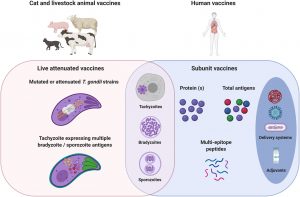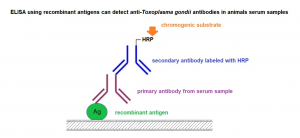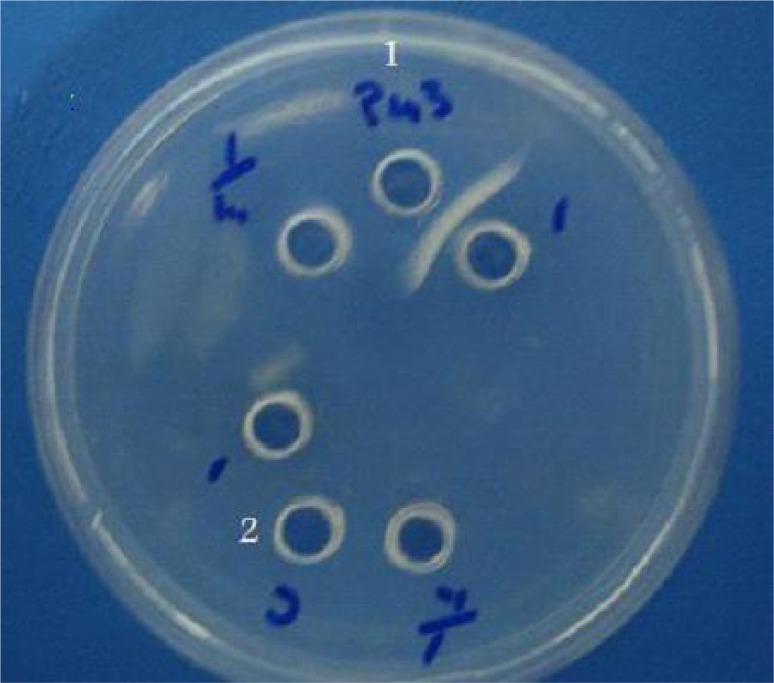Simple summary
Very common parasitic infections in animals are caused by members of the Apicomplexa, including Toxoplasma gondii Recombinants, Neospora sp. and Sarcocystis sp. These parasites pose serious veterinary problems. For example, the development of unambiguous diagnostic algorithms and determination of the correct diagnosis is hampered by the similar antigenic structure of these parasites, as well as the multitude of similar disease symptoms that occur in an infected animal.
The intracellular parasite, T. gondii, infects a wide range of warm-blooded animals, including humans. This parasite is widespread among different animal populations, contributes to reproductive loss and malformations in young individuals, and can become a serious economic concern for farmers. Additionally, the consumption of raw or undercooked meat and the consumption of dairy products derived from poorly processed farm animals are the main routes of transmission of the parasite in humans. This paper reviews potential improvements to diagnostic techniques using recombinant antigens for serodiagnosis of toxoplasmosis in various animal species.
Abstract
Toxoplasmosis is caused by an intracellular protozoan, Toxoplasma gondii, and is a parasitic disease that occurs in all warm-blooded animals, including humans. Toxoplasmosis is one of the most common parasitic diseases of animals and causes reproductive losses. Toxoplasmosis in humans is usually caused by eating raw or undercooked meat or consuming dairy products that contain the parasite. Currently, the diagnosis of toxoplasmosis is based on serological tests that use native antigens to detect specific anti-T antibodies. gondii antibodies. Due to the high price, commercially available agglutination assays are not suitable for testing large numbers of animal serum samples.

Recent developments in proteomics elucidated the antigenic structure of T. gondii and allowed the development of several recombinant antigens that can be used in new, cheaper, and more effective diagnostic tools. The continuous development of scientific disciplines, such as molecular biology and genetic engineering, allows the production of new recombinant antigens and lays the groundwork for new diagnostic tests for the detection of anti-T. gondii antibodies in animal serum samples.
Parasites and bacterial strains
The virulent strain RH (type I) of T. gondii, used for DNA extraction and preparation of toxoplasma lysate antigen (TLA), was maintained in vitro in the L929 cell line in Iscove’s Modified Dulbecco’s medium (Cytogen GmbH) with the addition of penicillin. (100kU/L, Sigma-Aldrich), streptomycin (100mg/L, Sigma-Aldrich), 2-mercaptoethanol (50µM, Sigma-Aldrich), and fetal bovine serum (5%, Cytogen GmbH). The DX (type II) strain of T. gondii, of intermediate virulence and highly cyst forming, was used to
Expression, purification and characterization of recombinant proteins
Clones positive for the E. coli BL21 (DE3) insert were identified by restriction endonuclease digestion, and plasmid DNA sequenced by Genomed Inc. (Warsaw, Poland). Alignment analysis of the cloned full-length rop18, as well as its 5′ and 3′ fragments, revealed complete identity with the published sequence (GenBank: AM075204.1). In an attempt to clone the rop5 gene, we obtained the rop5C isoform (GenBank: HQ916455.1), since the primers used for amplification were not isoform-specific.

Discussion
Recently, some studies showed that ROP5 and ROP18 proteins, very closely related members of the ROP2 family, are the main virulence factors of T. gondii (Behnke et al, 2012, El Hajj et al, 2006, El-Hajj et al, 2007a, El-Hajj et al, 2007b, Reese et al, 2011). The prominent role of these two antigens suggesting their potential as a vaccine or diagnostic tool focused our study on the generation of recombinant ROP5 and ROP18 proteins, as well as their fragments, to test antigenic properties.
Keywords:
Toxoplasma gondii; toxoplasmosis; recombinant antigens; serodiagnosis; animals

